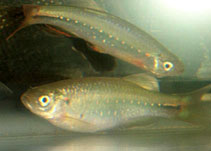http://www.fishbase.org/Summary/speciesSummary.php?genusname=Danio&speciesname=feegradei ---> http://192.134.151.83/Summary/speciesSummary.php?genusname=Danio&speciesname=feegradei
http://192.134.151.83/Summary/speciesSummary.php?genusname=Danio&speciesname=feegradei ---> https://fishbase.mnhn.fr/Summary/speciesSummary.php?genusname=Danio&speciesname=feegradei
https://fishbase.mnhn.fr/Summary/speciesSummary.php?genusname=Danio&speciesname=feegradei ---> https://fishbase.mnhn.fr/summary/Danio-feegradei.html
Danio feegradei

You can
sponsor
this page
Common name (e.g. trout)
Genus + Species (e.g. Gadus morhua)
-

-
About this page
-
Languages
-
User feedbacks
-
Citation
-
Uploads
-
Related species
-


 Upload your
photos
and
videos
Upload your
photos
and
videos
Pictures
|
Google image
 Danio feegradei
Danio feegradei
Picture by
Rowntree, P.
Classification / Names
Common names
|
Synonyms
| Catalog of Fishes(
genus
,
species
) |
ITIS
|
CoL
|
WoRMS
|
Cloffa
Teleostei (teleosts) >
Cypriniformes
(Carps) >
Danionidae
(Danios) > Danioninae
Etymology:
Danio:
From ‘dhani’, local Bengali/Bangla name for small minnows (Ref.
2031
)
.
More on author:
Hora
.
Environment: milieu / climate zone / depth range / distribution range
Ecology
Freshwater; benthopelagic. Tropical
Asia: Rakhine Yoma in Myanmar.
Size / Weight / Age
Maturity: L
m
?
range ? - ? cm
Max length : 6.8 cm SL male/unsexed; (Ref.
106271
)
Short description
Morphology
|
Morphometrics
Dorsal
soft rays
(total): 10;
Anal
soft rays
: 15 - 16;
Vertebrae
: 36 - 37.
Danio feegradei
is distinguished from all congeners except
D. bsconditus
by the presence of a large, elongate black spot at the base of the caudal fin (vs. absence; or minute and inconspicuous in
D. jaintianensis
,
D. choprae
and
D. flagrans
; or small, round and margined by a lighter zone in
D. erythromicron
), a small black or grey cleithral spot and a light (orange in life) spot immediately above the cleithral spot (vs. absent; or present, large and not bordered by light spot in
D. assamila
,
D. catenatus
,
D. concatenatus
,
D. dangila
, and
D. sysphigmatus
; or minute, not separated from P stripe and not associated with light spot in
D. meghalayensis
). It differs from all
Danio
except
D. absconditus
,
D. assamila
,
D. catenatus
,
D. concatenatus
,
D. dangila
,
D. meghalayensis
and
D. sysphigmatus
by the presence of a complete lateral line (vs. abbreviated or absent) and 14–16 circumpeduncular scales (vs. 10–12). It can be diagnosed from
D. absconditus
by the absence of dark vertical bars on abdominal sides (vs. presence of about 7–11 distinct dark bars), and presence of a dark area along the middle of the side, with two or three irregular horizontal rows of white dots (vs. absence of continuous dark area on anterior side and absence of white dots on the side) (Ref.
106271
).
Found in small coastal streams (Ref.
106271
).
Life cycle and mating behavior
Maturity
|
Reproduction
|
Spawning
|
Eggs
|
Fecundity
|
Larvae
Kullander, S.O. and R. Britz
, 2015. Description of
Danio absconditus
, new species, and redescription of
Danio feegradei
(Teleostei: Cyprinidae), from the Rakhine Yoma hotspot in south-western Myanmar. Zootaxa 3948(2):233-247. (Ref.
106271
)
IUCN Red List Status (Ref.
130435
)
Not Evaluated
CITES
Not Evaluated
Not Evaluated
Threat to humans
Harmless
Human uses
FAO - Publication:
search
|
FishSource
|
More information
Countries
FAO areas
Ecosystems
Occurrences
Introductions
Stocks
Ecology
Diet
Food items
Food consumption
Ration
Common names
Synonyms
Metabolism
Predators
Ecotoxicology
Reproduction
Maturity
Spawning
Spawning aggregation
Fecundity
Eggs
Egg development
Age/Size
Growth
Length-weight
Length-length
Length-frequencies
Morphometrics
Morphology
Larvae
Larval dynamics
Recruitment
Abundance
BRUVS
References
Aquaculture
Aquaculture profile
Strains
Genetics
Electrophoreses
Heritability
Diseases
Processing
Nutrients
Mass conversion
Collaborators
Pictures
Stamps, Coins Misc.
Sounds
Ciguatera
Speed
Swim. type
Gill area
Otoliths
Brains
Vision
Tools
E-book
|
Field guide
|
Length-frequency wizard
|
Life-history tool
|
Point map
|
Classification Tree
|
Catch-MSY
|
Special reports
Check for Aquarium maintenance
|
Check for Species Fact Sheets
|
Check for Aquaculture Fact Sheets
Download XML
Summary page
|
Point data
|
Common names
|
Photos
Internet sources
AFORO (otoliths) |
Aquatic Commons
|
BHL
|
Cloffa
|
BOLDSystems
|
Websites from users
|
Check FishWatcher
|
CISTI
|
Catalog of Fishes
:
genus
,
species
|
DiscoverLife
|
ECOTOX
| FAO - Publication:
search
|
Faunafri
| Fishipedia |
Fishtrace
| GenBank:
genome
,
nucleotide
| GloBI |
Google Books
|
Google Scholar
|
Google
| IGFA World Record |
MitoFish
|
Otolith Atlas of Taiwan Fishes
|
PubMed
| Reef Life Survey | Socotra Atlas |
Tree of Life
| Wikipedia:
Go
,
Search
| World Records Freshwater Fishing |
Zoobank
|
Zoological Record
Estimates based on models
Phylogenetic diversity index (Ref.
82804
): PD
50
= 0.5000 [Uniqueness, from 0.5 = low to 2.0 = high].
Bayesian length-weight: a=0.00457 (0.00175 - 0.01195), b=3.15 (2.92 - 3.38), in cm total length, based on LWR estimates for this (Sub)family-body shape (Ref.
93245
).
Trophic level (Ref.
69278
): 3.0 ±0.4 se; based on size and trophs of closest relatives
Resilience (Ref.
120179
): High, minimum population doubling time less than 15 months (Preliminary K or Fecundity.).
Fishing Vulnerability (Ref.
59153
): Low vulnerability (10 of 100).
Back to Search
Random Species
Back to Top
Accessed through:
Not available
FishBase mirror site :
localhost
Page last modified by :
mrius-barile
- 20 July 2016
Fatal error
: Uncaught ArgumentCountError: Too few arguments to function checkEcotox(), 1 passed in /var/www/html/summary/speciessummary.php on line 2304 and exactly 3 expected in /var/www/html/includes/speciessummary.lib.php:2579 Stack trace: #0 /var/www/html/summary/speciessummary.php(2304): checkEcotox() #1 {main} thrown in
/var/www/html/includes/speciessummary.lib.php
on line
2579
|